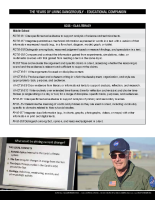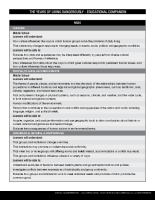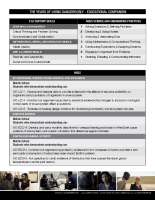
Download the standards tables for Middle School Lesson 1: NGSS and 21st Century Skills, CCSS, and NCSS.
You can also read the different standards applicable to Middle School Lesson 1 here.
21st Century Skills
Learning & Innovation
- Critical Thinking and Problem Solving
- Communication and Collaboration
Information, Media, &Technology Skills
- Media Literacy
Life & Career Skills
- Flexibility and Adaptability
- Social and Cross-Cultural Skills
NGSS Science and Engineering Practices
- Developing & Using Models
- Analyzing & Interpreting Data
- Using Mathematics & Computational Thinking
- Constructing Explanations & Designing Solutions
- Engaging in Argument from Evidence
- Obtaining, Evaluating, & Communicating Information
NGSS
Ecosystems: Interactions. Energy, and Dynamics (Middle School)
Students who demonstrate understanding can:
MS-LS2-1. Analyze and interpret data to provide evidence for the effects of resource availability on organisms and populations of organisms in an ecosystem.
MS-LS2-4. Construct an argument supported by empirical evidence that changes to physical or biological components of an ecosystem affect populations.
MS-LS2-5. Evaluate competing design solutions for maintaining biodiversity and ecosystem services.
Earth’s System (Middle School)
Students who demonstrate understanding can:
MS-ESS2-6. Develop and use a model to describe how unequal heating and rotation of the Earth cause patterns of atmospheric and oceanic circulation that determine regional climates.
Earth and Human Activity (Middle School)
Students who demonstrate understanding can:
MS-ESS3-4. Construct an argument supported by evidence for how increases in human population and per-capita consumption of natural resources impact Earth’s systems.
MS-ESS3-5. Ask questions to clarify evidence of the factors that have caused the rise in global temperatures over the past century.
CCSS – ELA
Science and Technical Subjects, Writing, and History/Social Studies (Middle School)
RST.6-8.1 Cite specific textual evidence to support analysis of science and technical texts.
RST.6-8.7 Integrate quantitative or technical information expressed in words in a text with a version of that information expressed visually (e.g., in a flowchart, diagram, model, graph, or table).
RST.6-8.8 Distinguish among facts, reasoned judgment based on research findings, and speculation in a text.
RST.6-8.9 Compare and contrast the information gained from experiments, simulations, video, or multimedia sources with that gained from reading a text on the same topic.
RI.8.8 Trace and evaluate the argument and specific claims in a text, assessing whether the reasoning is sound and the evidence is relevant and sufficient to support the claims.
WHST.6-8.1 Write arguments focused on discipline content.
WHST.6-8.4 Produce clear and coherent writing in which the development, organization, and style are appropriate to task, purpose, and audience.
WHST.6-8.9 Draw evidence from literary or informational texts to support analysis, reflection, and research.
WHST.6-8.10 Write routinely over extended time frames (time for reflection and revision) and shorter time frames (a single sitting or a day or two) for a range of discipline- specific tasks, purposes, and audiences.
RH.6-8.1 Cite specific textual evidence to support analysis of primary and secondary sources.
RH.6- 8.4 Determine the meaning of words and phrases as they are used in a text, including vocabulary specific to domains related to history/social studies.
RH.6-8.7 Integrate visual information (e.g., in charts, graphs, photographs, videos, or maps) with other information in print and digital texts.
RH.6-8.8 Distinguish among fact, opinion, and reasoned judgment in a text.
NCSS
Culture (Middle School)
Learners will understand:
- How culture influences the ways in which human groups solve the problems of daily living;
- That culture may change in response to changing needs, concerns, social, political, and geographic conditions.
Learners will be able to:
- Evaluate how data and experiences may be interpreted differently by people from diverse cultural perspectives and frames of reference;
- Draw inferences from data about the ways in which given cultures respond to persistent human issues, and how culture influences those responses.
People, Places, & Environments (Middle School)
Learners will understand:
- The theme of people, places, and environments involves the study of the relationships between human populations in different locations and regional and global geographic phenomena, such as landforms, soils, climate, vegetation, and natural resources;
- Past and present changes in physical systems, such as seasons, climate, and weather, and the water cycle, in both national and global contexts;
- Human modifications of the environment;
- Factors that contribute to the cooperation’s and conflict among peoples of the nation and world, including language, religion, and political beliefs.
Learners will be able to:
- Acquire, organize, and analyze information and use geographic tools to draw conclusions about historic or current national and global environmental change;
- Evaluate the consequences of human actions in environmental terms.
Individuals, Groups, & Institutions (Middle School)
Learners will understand:
- That groups and institutions change over time;
- That institutions may promote or undermine social conformity;
- That when two or more groups with differing norms and beliefs interact, accommodation or conflict may result;
- That groups and institutions influence culture in a variety of ways.
Learners will be able to:
- Understand examples of tensions between belief systems and governmental actions and policies;
- Investigate conflicts between expressions of individuality and group conformity;
- Evaluate how groups and institutions work to meet individual needs and promote or fail to promote the common good.
Power, Authority & Governance (Middle School)
Learners will be able to:
- Examine persistent issues involving the rights of individuals and groups in relation to the general welfare;
- Analyze and evaluate conditions, actions, and motivations that contribute to conflict and cooperation among groups and nations;
- Evaluate the role of technology as it contributes to conflict and cooperation among nations and groups, and as it contributes to or detracts from systems of power, authority, and governance.
Production, Distribution, & Consumption (Middle School)
Learners will understand:
- Individuals, government, and society experience scarcity because human wants and needs exceed what can be produced from available resources;
- The economic choices people make have both present and future consequences.
Learners will be able to:
- Ask and find answers to questions about the production and distribution of goods and services in the state and nation, and in a global context;
- Compare their own economic decisions with those of others, and consider the wider consequences of those decisions for groups, communities, the nation, and beyond;
- Analyze various methods for allocating scarce goods and services at the state, national, and global levels, describing the possible impacts of these choices.
Science, Technology, Society (Middle School)
Learners will understand
- Society often turns to science and technology to solve problems;
- Our lives today are media and technology dependent;
- Science and technology have had both positive and negative impacts upon individuals, societies, and the environment in the past and present;
- Science and technology have changed peoples’ perceptions of the social and natural world, as well as their relationship to the land, economy and trade, their concept of security, and their major daily activities.
- Values, beliefs, and attitudes that have been influenced by new scientific and technological knowledge;
- How media are created and received depends upon cultural contexts;
- Science and technology sometimes create ethical issues that test our standards and values.
Learners will be able to:
- Ask and find answer to questions about the ways in which science and technology affect peoples’ lives today in different places, and have done so in the past;
- Use diverse types of media technology to read, write, create, and review a variety of messages;
- Select, organize, evaluate, and communicate information about the impact of science or technology on a society today or in the past;
- Use scientific findings and forms of technology to formulate possible solutions to real-life issues and problems, and predict outcomes.
Global Connections (Middle School)
Learners will understand:
- Spatial relationships that relate to ongoing global issues (e.g. pollution, poverty, disease, and conflict) affect the health and well-being of Earth and its inhabitants;
- Global problems and possibilities are not generally caused or developed by any one nation;
- Universal human rights cut across cultures but are not necessarily understood in the same way in all cultures.
Learners will be able to:
- Analyze examples of conflict, cooperation, and interdependence among groups, communities, regions, societies, and nations;
- Explore the causes, consequences, and possible solutions related to persistent, current, and emerging global issues, such as health, resource allocation, economic development, and environmental quality;
- Describe and explain the relationships and tensions between national sovereignty and global interests in such matters as territorial rights, natural resources, trade, the different uses of technology, and the welfare of people
Civic Ideals and Practices (Middle School)
Learners will understand:
- The theme of civic ideals and practices helps us to learn about and know how to work for the betterment of society;
- The importance of becoming informed in order to make positive civic contributions.
Learners will be able to:
- Ask and find answers to questions about how to become informed and take civic action;
- Build background through research in primary and secondary sources, make decisions, and propose solutions to address problems;
- Identify assumptions, misconceptions, and bias in sources, evidence, and arguments used in presenting issues and positions;
- Identify, seek, describe, and evaluate multiple points of view about selected issues, noting the strengths, weaknesses, and consequences associated with holding each position;
- Develop a position on a public policy issue, and defend it with evidence.




